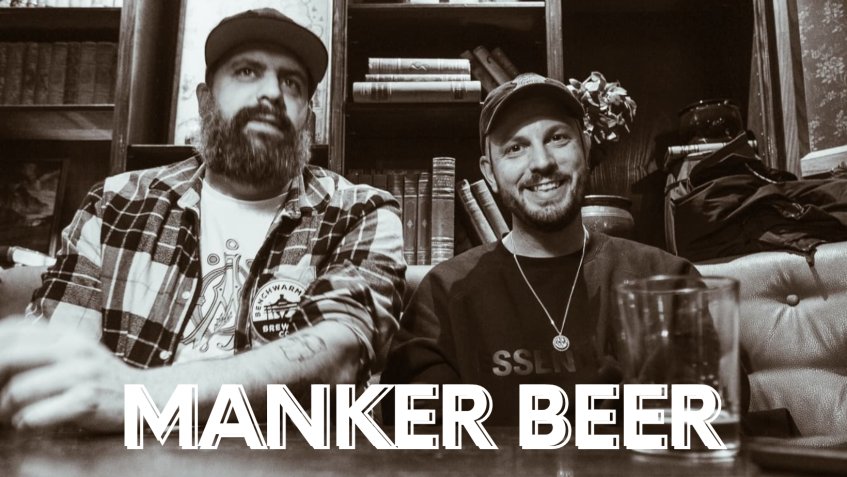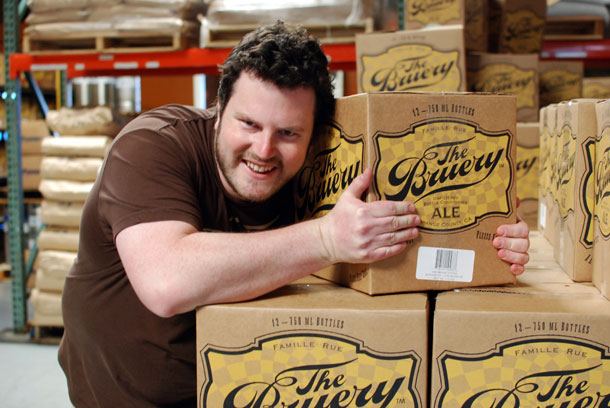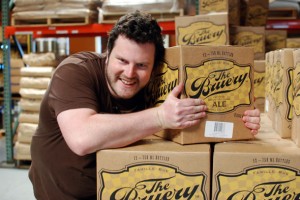I remember my first three beers from California based brewery The Bruery. This was at the beginning of my evolution as a beer writer and beer lover and I remember how they opened a whole new world of beers for me. They were uncommon in the way that they used “unusual” spices and had flavors my rookie palate hadn’t experienced before. As time passed and I had my first taste of the 19.2% ABV imperial stout Black Tuesday, by then the most expensive beer I had ever tried I got to learn that as a Swede The Bruery’s beers were not to be found easily, neither to be taken lightly. This was back in 2009/2010, only 1-2 years after Patrick Rue opened the brewery in Placentia, California. Since then a lot has happened, both for myself and my journey into the land of craft beer but also for The Bruery. In 5 years time they have managed to open up and close a specialty store in Orange County which provided customers with beer, cheese, wine etc, they have earned several awards for their beers and have now grown and reached the peak of where it might be time with further expansion.
Over the last year I have been lucky enough to get to try a representative variety of The Bruery beers as several have been available in Copenhagen while some have been aquired through beer trades or as gifts. The often high ABV beers follow the US craft beer “trend” where the breweries go their own way and thanks to a loyal fan base they dare to experiment with flavors, styles and additions of unsual ingredients. For our MankerBeer Meets-series leading up to Great American Beer Festival we have tried to focus on the most prominent breweries among these and we are now happy to present you with Patrick Rue of The Bruery.
MankerBeer (MB): After attending law school you chose a different path and went all in for another passion, brewing beer. When did you begin brewing at home and when did you realize that brewing was the passion to follow in life?
Patrick Rue (PR): I began homebrewing at the beginning of my first year in law school in 2003. Rachel, my wife, told me I needed a hobby because all I was doing was studying and going to classes, and I had become a boring person. Once I started homebrewing, I immediately became hooked– it dominated most of my time (and I became boring in a different way)! When it came time to choosing what I’d be doing for a career, I didn’t have a mortgage, or kids, or anything to lose, so Rachel and I took a chance and started a brewery. Luckily my family supported the idea and provided the funding.
MB: Was it set from the start that you would focus on Belgian(-‘ish) beers? What had inspired you?
PR: Belgian-style beers have always been among my favorite styles to brew and drink. The wide range of styles, characteristic strong yeast character (high attenuation, fruit driven esters), ability use of spices, fruit, oak barrels, souring bacteria– these are the beers I love to make and they are a lot of fun to drink. Spending some time in Belgium with my wife before starting up The Bruery helped solidify my excitement of Belgian beer and its culture.
MB: In retrospect, have The Bruery become the brewery of your dreams? Would you have done anything differently or are there things you wish to adjust or add in the future?
PR: The Bruery has grown beyond my wildest dreams, about double the size of my initial very optimistic business plan at this point. At this point, we’ve grown about as large as we can in our brewery, but we don’t have any immediate plans to start a new brewery. With the crazy growth of other craft breweries and the amount of new brewery entrants, I think this is a perfect time to take a breather before taking on any major expansions.
MB: Beer conservatives and non-understanders tend to criticize breweries that brew strong or oddly spiced beers. Compared to drinking heavy, high ABV wine they have a hard time drinking beers above 7-8% ABV. Several of your beers are on the higher %-scale, are people sometimes too narrow in their perception of what a beer can be?
PR: I accept that not everyone is going to enjoy our beers, we’re a niche brewery and by design we know we aren’t going to be everyone’s favorite brewery. We create pretty unique beers that certainly aren’t for everyone. I do think our beers are pretty balanced, even our very high ABV beers. I feel that we’re successful as long as we have a small but loyal following of customers.
MB: The demand for, and interest in US craft beer has seen a crazy increase over the last few years resulting in a demand which seems difficult for many breweries to satisfy. For The Bruery a beer such as Black Tuesday could sell out before even being brewed. How do you handle the demand, trying to satisfy as many as possible but not letting go of the year round or “regular” special beers?
PR: We’ve attempted to deal with our demand with our more time / labor / cost intensive beers by creating several clubs (Preservation Society / Reserve Society / Hoarders Society) where our biggest supporters can have guaranteed access to these beers. We realized a few years ago there is no point in meeting demand with beers like this would consume too much of our efforts. We like brewing new things, not just the same old beers, and our capacity is only what it is.
MB: Is it possible for the US craft beer scene to keep growing? Will it be possible for breweries such as yours to satisfy more than only a few core markets? Do you want to go inter/-national?
PR: It is certainly possible for the US craft beer scene to keep growing– craft beer’s market share by volume in the U.S. is well below 10% (much lower in other parts of the world), and most breweries are in a growth spurt right now. It’s not my priority to satisfy demand– at this point we aren’t looking for permanent tap placements, we like our beers to be at the right places (specialty markets, great restaurants and craft beer bars), and we’re already fairly wide spread, distributing to 22 states and a few countries. Niche breweries tend to need a shallow, wide distribution model, or severely limit production and sell most production on-site and locally. I think we have room for growth, but I don’t see us trying to become a large player in the overall craft beer industry, though certainly we want to be a big player our niche of craft beer. I like being the niche brewery, being able to create what we’d like and be able to find a home for it.
MB: I am constantly amazed with how great friends most brewers seems to be, it’s like one huge family sharing a common dream. What brewers do you admire and/or have inspired you the most?
PR: That’s a tough question, I admire a lot of folks in this industry. Getting started, local brewers Rick Smets (formerly of Left Coast, starting up Stereo Brewing) and Dave Moody (formerly of Back Street, now at Alcatraz Brewing) let me hang out with them and helped me understand how professional brewing is different from homebrewing. Matt Brynildson is someone I admired as a homebrewer and still greatly admire, and had the opportunity to taste through most of the barrels of the Firestone 10th anniversary blend with him (I won it as a Best of Show prize– cool, huh?). This was a great opportunity to understand how their barrel program works, and the amazing things that can happen when the right beers are blended together. Guys like Tomme Arthur and Vinnie Cilurzo were quite helpful in advice on barrel aging and packaging. Steve Wagner and Greg Koch at Stone were amazingly helpful with bouncing off ideas for my business plan, and became our first distributor when other smaller distributors weren’t willing to take a chance on a crazy homebrewer.
MB: Beer blogs, ratebeerians and “beer experts” are growing in numbers, do people tend to be too serious and nerdy about beer nowadays or is it fun too see people sharing the interest in great craftmanship?
PR: I think it’s great that there is such a large following for craft beer, and that people are willing to share their beer experiences with others. These are educated beer drinkers and some of our biggest supporters. The increase in communication that the web has provided is certainly one of the big factors in craft beers growth, and we follow BeerAdvocate, RateBeer, beer blogs, etc. very closely and try to be a part of these communities as well.
MB: So, GABF. What are you looking forward to with GABF and how important is the festival for breweries and the American beer scene?
PR: I’m looking forward to seeing old friends, and making new ones. GABF is a very large festival, so it’s difficult to stand out or be remembered when the week is over. Winning medals certainly help with this. The GABF experience for the attendee shows how diverse and alive craft beer is right now, and the love brewers put into their beers. Just reading articles and seeing pictures from the event shows the world how important craft beer has become.
MB: For all GABF-debutants, what should one think about and/or not miss at GABF?
PR: I love trying beers from breweries that I don’t get to try on a regular basis. I try to spend a good amount of time visiting breweries that have just started in the last year and try their lineup, followed by some favorite breweries of mine that don’t have distribution in Southern California (Cigar City, Perennial (who I was introduced to last year), Founders, Bells, the list goes on…). Sam Adams Utopias is always a priority as well, great stuff!
MB: What cool The Bruery brews will be poured at the festival?
PR: We’ll be pouring some pretty fun beers– Chocolate Rain, Oude Tart with Cherries, and Sour in the Rye with Peaches, along with a few others.
We are greatful for stealing some time from Patrick who have been busy travelling Belgium (read all about it on The Bruery blog) and we hope to be able to offer all you MankerBeer readers out there a follow up article on the brewery as we will try to make it there during our post-GABF trip to California. Until then, cheers and keep on rockin’.




